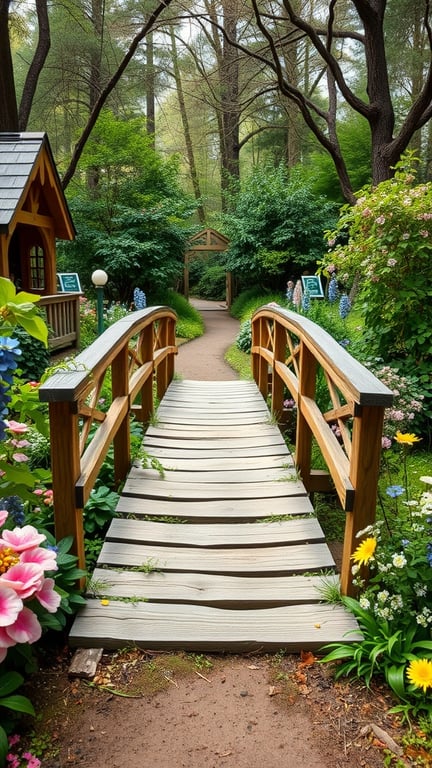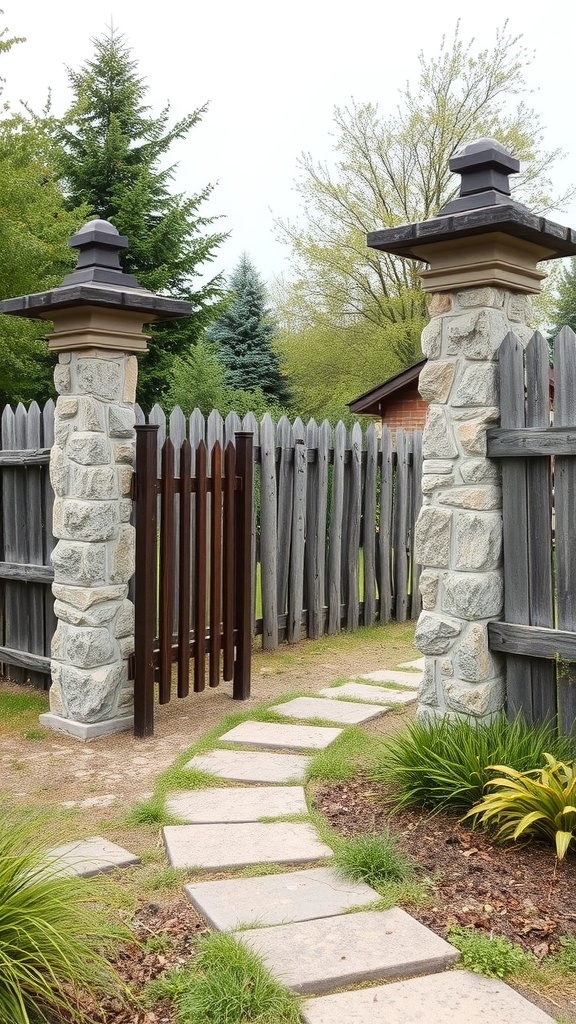25+Creative Small Garden Ideas to Transform Your Space
Small gardens can be charming and versatile, offering a slice of nature in any space. Here are over 25+ creative ideas to help you make the most of your limited area, whether you want to cultivate a peaceful retreat or a vibrant edible landscape.
Container Gardening for Limited Spaces
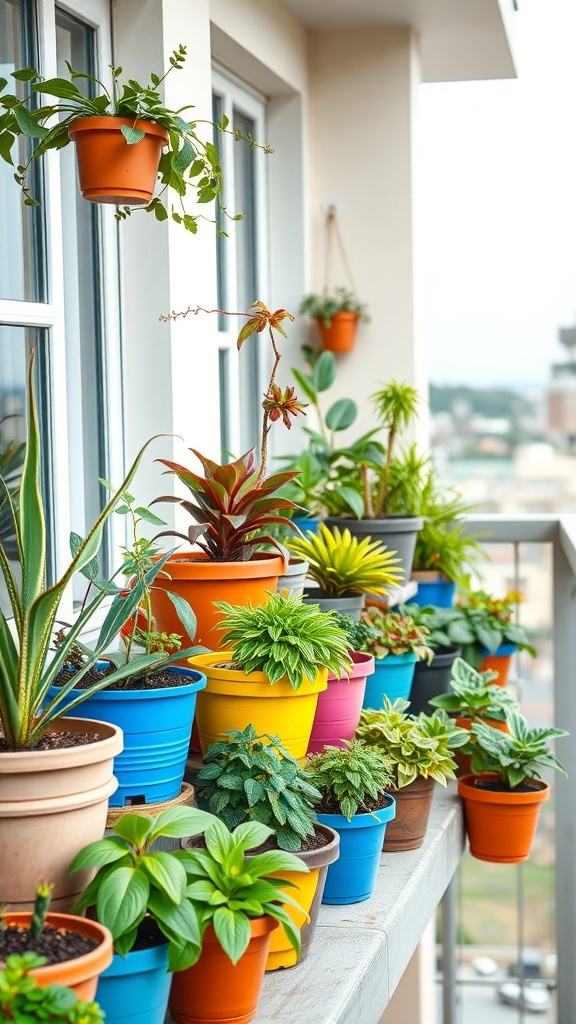
Container gardening is a fantastic way to bring greenery into small spaces. The image shows a vibrant collection of potted plants lined up on a balcony. Each pot adds a splash of color, making the space feel lively and inviting.
Using containers allows you to maximize your gardening potential without needing a large yard. You can choose various sizes and shapes to fit your style. From herbs to flowers, the options are endless.
Consider using vertical space by hanging pots or stacking them. This not only saves space but also creates a beautiful visual display. Mixing different plants in one container can add texture and interest.
Don’t forget about drainage! Ensure your pots have holes at the bottom to prevent overwatering. Using lightweight potting soil can also make it easier to move your plants around.
Lastly, think about sunlight. Position your containers where they can get the right amount of light for the plants you choose. With a little creativity, you can turn any small area into a green paradise.
Succulent Arrangements in Small Spaces
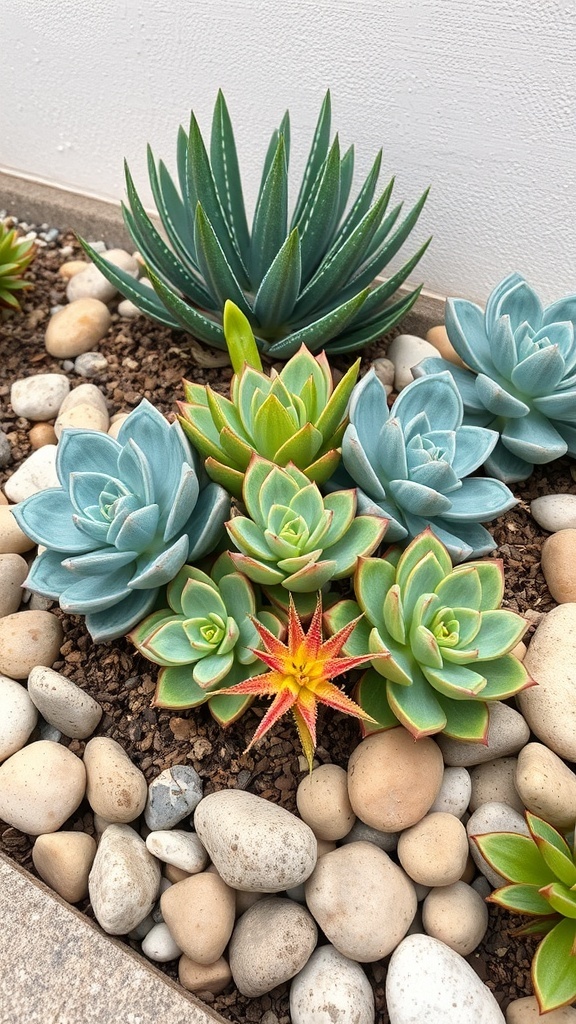
Succulents are perfect for small gardens. They come in various shapes and colors, making them visually appealing. This image shows a lovely arrangement of different succulents, each with its unique texture and hue.
The combination of greens, blues, and a pop of red creates a vibrant look. The pebbles surrounding the plants add a nice touch, enhancing the overall design. This setup is not only attractive but also low maintenance, ideal for busy individuals.
Consider using containers or vertical gardens to maximize space. You can mix and match different types of succulents for a dynamic display. Using a variety of sizes can create depth and interest in your small garden.
Raised Bed Gardening Techniques

Raised bed gardening is a fantastic way to maximize your small garden space. The image shows a vibrant layout of various raised beds filled with colorful flowers and lush greens. Each bed is neatly organized, making it easy to access and maintain.
Using raised beds allows for better soil drainage and easier weed control. You can customize the soil mix to suit the plants you want to grow. This technique is perfect for growing vegetables, herbs, and flowers all in one compact area.
Consider using different materials for your raised beds, like wood or stone, to add character to your garden. Mixing in decorative pots can also enhance the visual appeal. Grouping plants with similar water and sunlight needs will make care simpler.
Don’t forget to add pathways between the beds for easy access. This layout not only looks good but also makes gardening more enjoyable. Raised beds can be a great way to introduce kids to gardening, making it a fun family activity.
Vertical Gardening Solutions
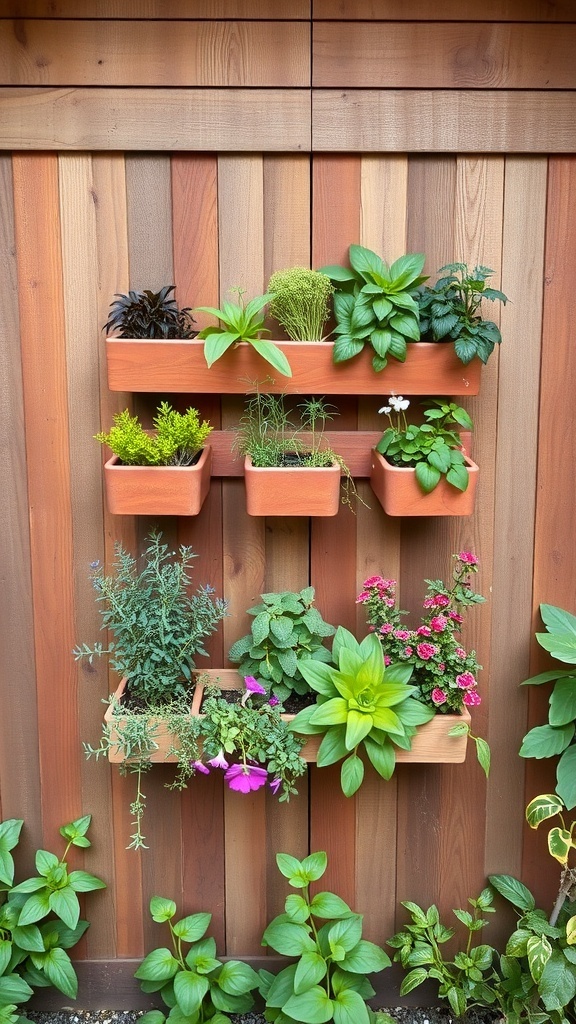
Vertical gardening is a fantastic way to maximize space, especially in small gardens. The image shows a beautiful vertical garden setup against a wooden fence. It features various plants arranged in wall-mounted planters, creating a stunning green display.
This approach not only saves ground space but also adds visual interest to your garden. You can choose a mix of herbs, flowers, and leafy greens to create a vibrant look. Consider using lightweight pots to make installation easier.
Another idea is to incorporate different heights and textures. This adds depth and makes your vertical garden more dynamic. You can even use recycled materials like wooden pallets or old crates for a rustic charm.
Don’t forget about the watering system! Drip irrigation or self-watering pots can help keep your plants healthy without much effort. Vertical gardening is not just practical; it’s also a fun way to express your creativity in a small space.
Edible Landscaping Designs

Edible landscaping is a fun way to combine beauty and functionality in your garden. Imagine walking through a small garden filled with vibrant plants that not only look great but also provide fresh produce. This image showcases a lovely patch of tomato plants, ripe and ready for harvest.
Using tomatoes as an example, they can be grown in various ways, from traditional garden beds to vertical planters. This allows you to maximize space while enjoying the fruits of your labor. Pairing tomatoes with herbs like basil or parsley can create an attractive and aromatic garden.
Consider adding trellises or stakes to support your plants. This not only helps them grow tall and healthy but also adds a decorative element to your garden. You can even mix in edible flowers like nasturtiums for a pop of color and added flavor in your dishes.
Another idea is to integrate fruit-bearing shrubs, such as blueberries or raspberries, into your landscape. They can serve as beautiful borders while providing delicious snacks. With a little creativity, your small garden can become a delightful space for both relaxation and culinary enjoyment.
Creative Use of Trellises

Trellises can transform a small garden into a lush retreat. They provide vertical space for climbing plants, making your garden feel bigger and more vibrant.
In the image, you see a trellis adorned with greenery. This not only adds beauty but also creates a natural privacy screen. The climbing plants weave through the structure, bringing life to the walls.
Consider using trellises to define areas in your garden. They can act as dividers, guiding the eye and creating cozy nooks. You can also train flowering vines to climb, adding pops of color throughout the space.
Another idea is to mix different plant types on a single trellis. Combining flowers and foliage can create a stunning visual effect. Plus, it attracts pollinators, which are essential for a healthy garden.
Don’t forget about the materials! Wooden trellises offer a rustic charm, while metal ones can add a modern touch. Choose what fits your style best.
Miniature Herb Spiral
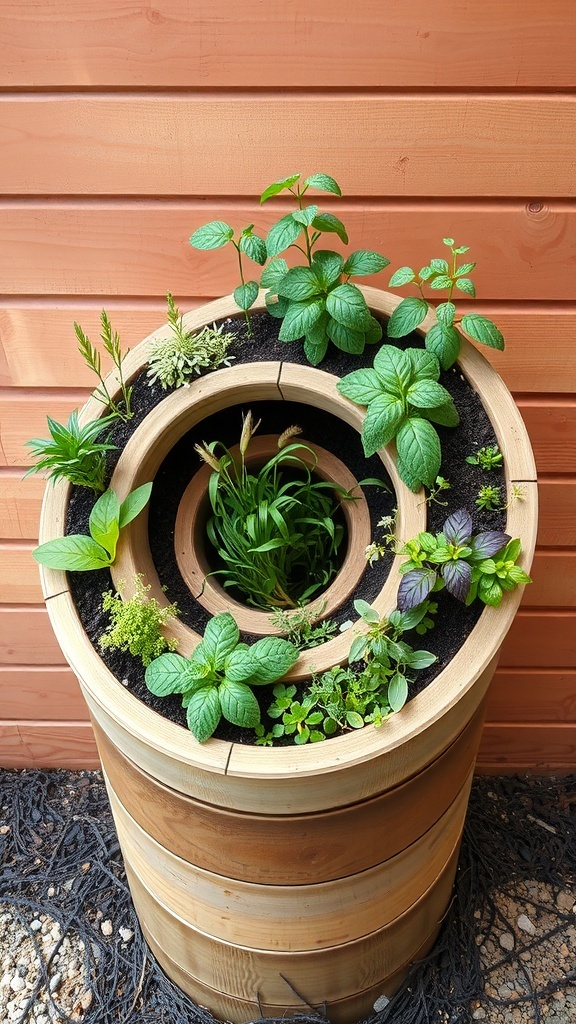
A miniature herb spiral is a fun and efficient way to grow herbs in a small space. This design allows you to maximize vertical space while creating a beautiful focal point in your garden.
The spiral shape provides different microclimates, which means you can grow a variety of herbs that have different light and water needs. For instance, the top of the spiral can be drier and sunnier, perfect for Mediterranean herbs like rosemary and thyme, while the lower sections can retain more moisture for herbs like mint and parsley.
Building a herb spiral is simple. You can use stones, bricks, or even wooden barrels to create the spiral structure. Fill it with quality soil and plant your favorite herbs. This setup not only looks great but also makes it easy to access your herbs for cooking.
Consider adding a few decorative elements, like small stones or garden ornaments, to personalize your herb spiral. It’s a charming addition to any small garden and encourages you to use fresh herbs in your meals!
Garden Pathways with Natural Materials
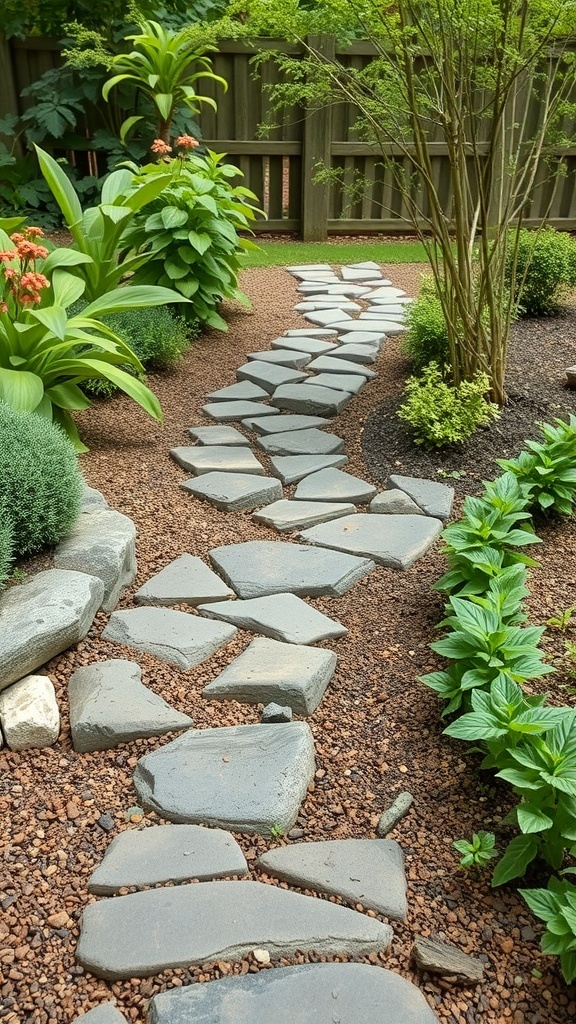
Creating a garden pathway using natural materials can add charm and warmth to your outdoor space. The image shows a lovely stone pathway winding through lush greenery. This kind of design invites you to stroll through the garden, making it feel more welcoming.
Using materials like stone, gravel, or wood can blend beautifully with plants. The pathway in the image features flat stones, which are easy to walk on and provide a rustic look. Surrounding the path with vibrant plants enhances the natural feel, making the garden feel alive.
Consider using different shapes and sizes of stones to create a unique pattern. You can also mix in gravel or mulch to fill the gaps, which adds texture and keeps weeds at bay. This approach not only looks great but is also practical.
Adding lighting along the pathway can create a magical atmosphere in the evening. Solar lights or lanterns can guide your way while highlighting the beauty of your garden. A well-designed pathway can transform your garden into a serene retreat.
Wildflower Patches for Pollinators

Creating wildflower patches is a fantastic way to attract pollinators like bees and butterflies to your garden. These vibrant blooms not only add color but also support local ecosystems.
Consider planting a mix of native flowers. They are well-suited to your local climate and soil, making them easier to care for. Flowers like coneflowers, daisies, and black-eyed Susans are great options.
Position your wildflower patch in a sunny spot. Pollinators love warmth and light, so a sunny area will encourage them to visit. Make sure to leave some space for the flowers to grow and spread.
Watering is key, especially during dry spells. Regular watering helps the flowers thrive, ensuring they attract more pollinators. You can also avoid pesticides, as they can harm these beneficial creatures.
Lastly, enjoy the beauty and activity in your garden. Watching pollinators at work can be a rewarding experience. It’s a simple yet impactful way to contribute to nature.
Water Features in Compact Gardens

Water features can add a delightful touch to small gardens. A fountain, like the one shown in the image, serves as a focal point while providing soothing sounds of flowing water.
Incorporating a fountain can create a serene atmosphere. It attracts birds and other wildlife, enhancing the natural feel of your garden.
Consider placing the fountain in a central location, surrounded by lush greenery. This setup not only looks appealing but also helps to mask any noise from nearby streets.
Smaller water features, such as a mini pond or a birdbath, can also work well in compact spaces. These options are easy to maintain and can fit into various garden styles.
Lighting around the water feature can create a magical effect at night. Use solar lights or small lanterns to highlight the beauty of your garden.
Seasonal Plant Rotation Strategies
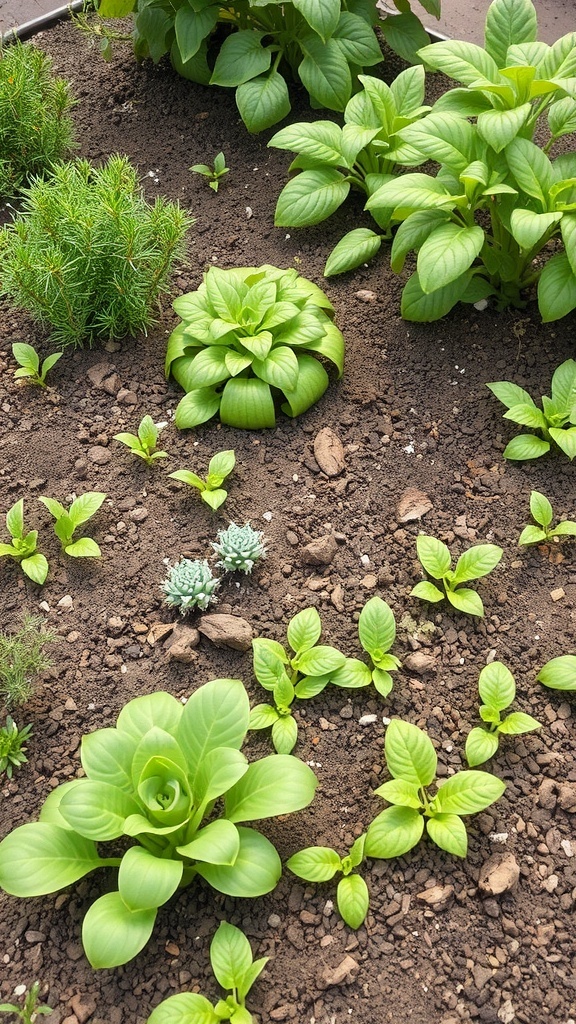
Seasonal plant rotation is a smart way to keep your garden healthy and thriving. The image shows a vibrant mix of young plants, including leafy greens and herbs, all set in rich soil. This variety not only looks great but also helps in maintaining soil health.
One idea is to plant fast-growing crops like lettuce or radishes in early spring. Once harvested, you can replace them with slower-growing plants like tomatoes or peppers. This keeps the soil active and ensures you get the most out of your space.
Another strategy is to group plants with similar needs together. For instance, pairing herbs with vegetables can help deter pests and improve growth. The plants in the image show how different types can coexist, making the garden both functional and beautiful.
Don’t forget to consider your climate and the seasons. Some plants thrive in cooler weather, while others prefer the heat. Rotating your crops according to the season can lead to a more productive garden.
Vertical Planters for Small Patios
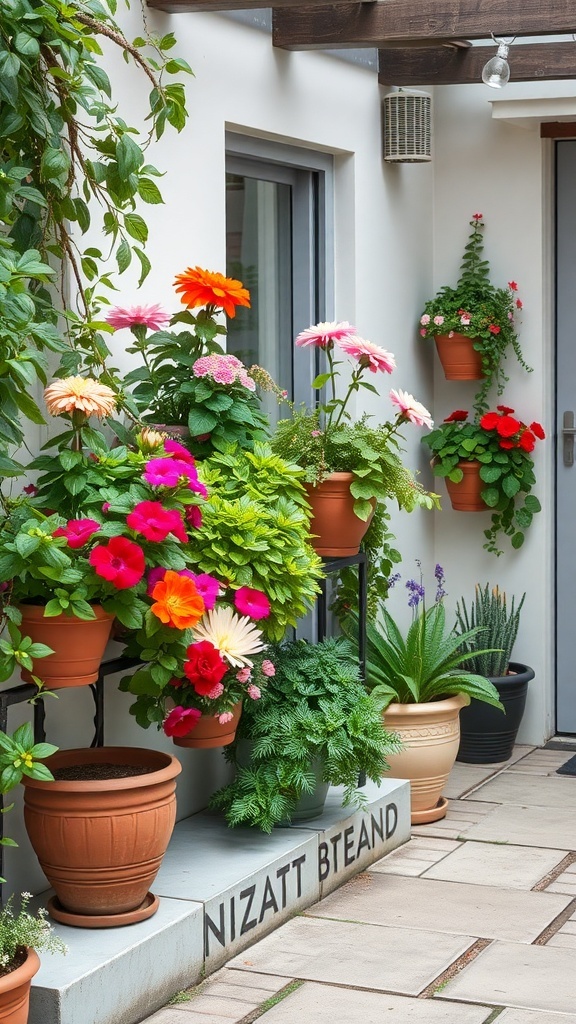
Vertical planters are a fantastic way to maximize space in small patios. They allow you to add greenery without taking up too much room. Imagine vibrant flowers cascading down a wall or climbing up a trellis. It creates a lively atmosphere that can brighten any small area.
In the image, you can see a lovely arrangement of colorful flowers in various pots. The vertical setup not only looks stunning but also makes maintenance easier. You can reach each plant without needing to bend down or crawl around on the ground.
Consider using different types of plants for variety. Mixing flowers with trailing greenery can create a beautiful contrast. Herbs can also be a great addition, providing both beauty and functionality.
Another idea is to use wall-mounted shelves or hanging pots. They can be arranged in a way that fits your style. This approach allows you to personalize your space while keeping it organized.
Don’t forget about lighting! Adding string lights or lanterns can enhance the charm of your vertical garden, especially in the evening.
Creative Use of Garden Furniture
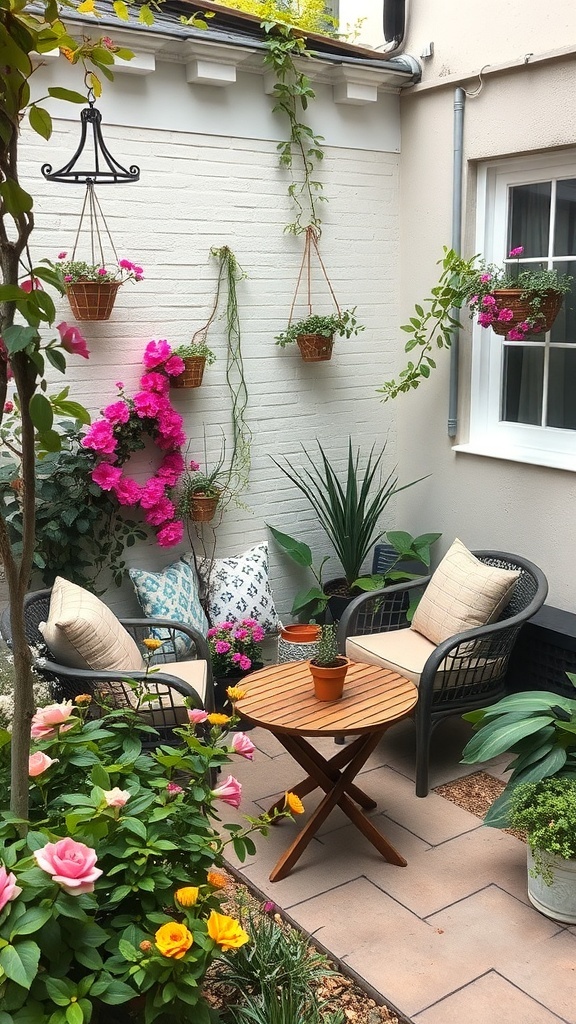
Using garden furniture creatively can transform a small space into a cozy retreat. In the image, we see a charming setup that invites relaxation and enjoyment. The combination of comfortable chairs and a simple table creates a perfect spot for morning coffee or evening chats.
Consider adding colorful cushions to the chairs for a pop of color and extra comfort. The surrounding flowers and hanging plants enhance the natural beauty of the space, making it feel vibrant and welcoming. A small table is ideal for holding drinks or snacks while you unwind.
Another idea is to use multi-functional furniture. A bench with storage can be both a seat and a place to keep gardening tools or cushions. This not only saves space but also keeps the area tidy.
Incorporating lighting, like string lights or lanterns, can add a magical touch for evening gatherings. Think about how you can arrange your furniture to maximize the view of your garden. Positioning chairs to face the flowers can create a lovely focal point.
Colorful Flower Borders
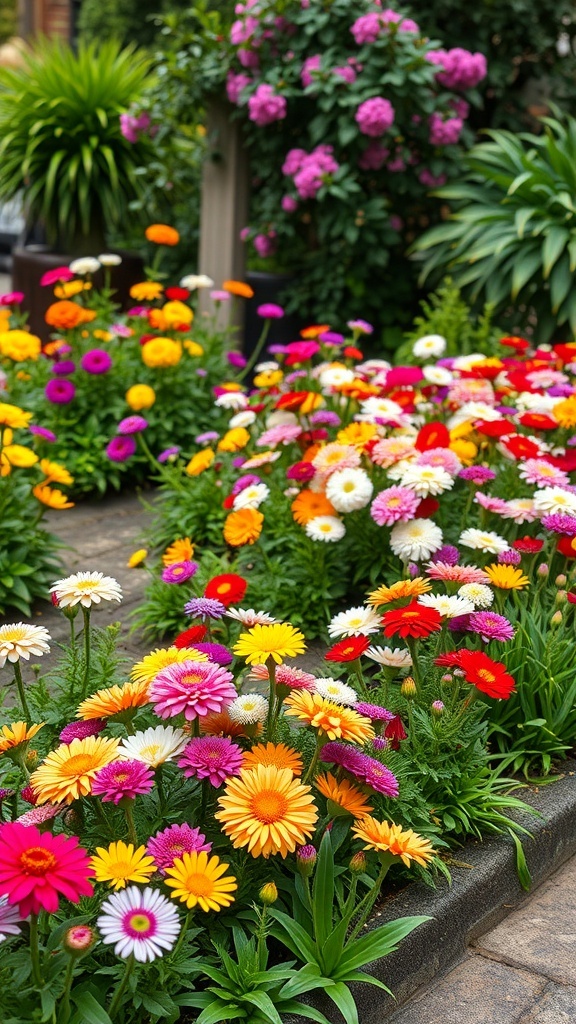
Flower borders can bring life to any small garden. Imagine a vibrant line of flowers framing your space, creating a welcoming vibe. The image shows a stunning array of flowers in various colors, from bright yellows to soft pinks. This mix adds charm and character to the garden.
To create your own colorful flower border, choose a variety of flowers that bloom at different times. This way, your garden stays lively throughout the seasons. Consider using perennials for lasting beauty and annuals for quick pops of color.
Don’t forget about height! Layer taller flowers at the back and shorter ones in front. This creates depth and makes your garden visually appealing. You can also mix in some greenery to enhance the colors of the flowers.
Using flower borders is a simple way to make your garden feel more inviting. With a little planning, you can create a stunning display that will impress anyone who visits.
Shade Gardens for Limited Sunlight
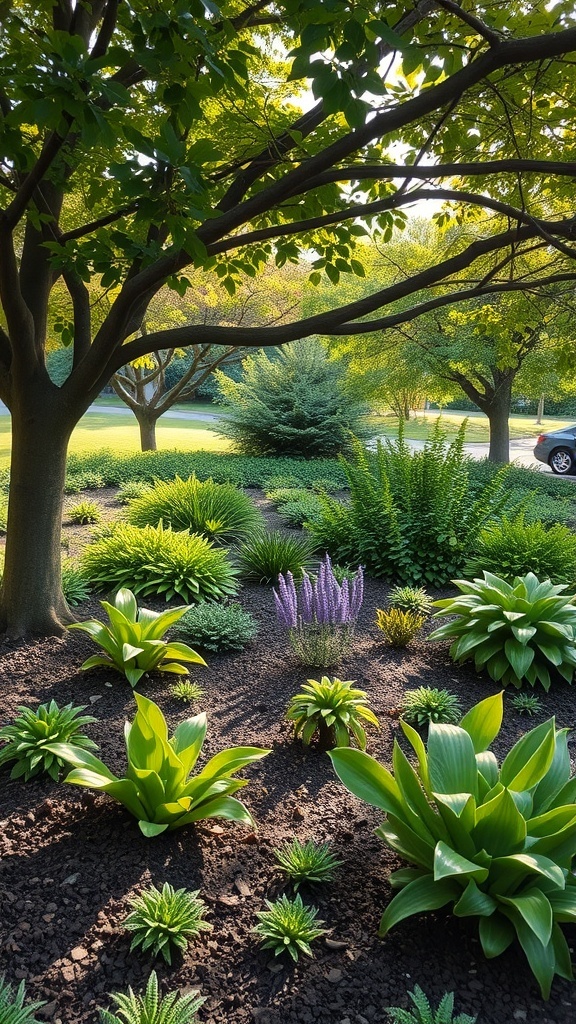
Creating a shade garden can be a rewarding way to make the most of areas in your yard that don’t get much sunlight. The image showcases a lush garden filled with various plants thriving under the canopy of trees. This setting highlights how vibrant greenery can flourish even in limited light.
Consider using plants like hostas, ferns, and astilbes, which are known for their ability to thrive in shade. They add texture and color, making the garden visually appealing. The combination of different leaf shapes and sizes creates a dynamic look.
Mulching is another great idea for shade gardens. It helps retain moisture and suppress weeds, making maintenance easier. Dark mulch can also enhance the colors of the plants, creating a striking contrast.
Incorporating pathways or stepping stones can add structure to the garden. This not only makes it easier to navigate but also invites visitors to explore the beauty of the plants up close.
Lastly, don’t forget about adding some decorative elements like garden art or a small bench. These touches can make the space feel cozy and inviting, perfect for enjoying the tranquility of a shaded retreat.


